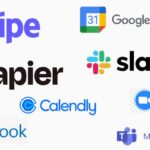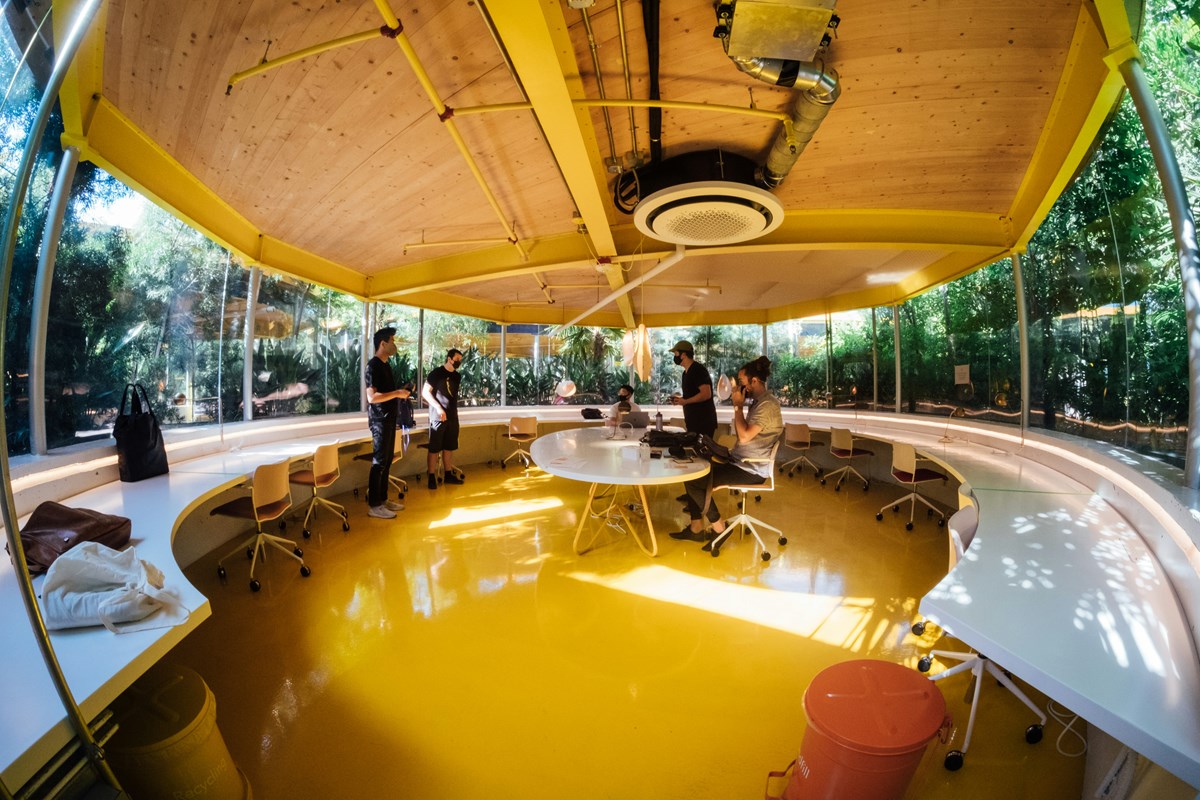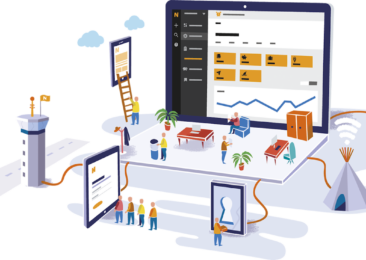- Coworking
- Coworking Resources
Your Coworking Software Blueprint for Operational Success

We’ve pulled together a guide to coworking software, with help from the people who sell it.
Why do we need software for flexible workspaces? Coworking isn’t just a trend anymore; it’s a huge part of how we work today.
Behind every buzzing flex space, the management software is an operational hub, pulling together daily tasks, removing the admin you really shouldn’t be doing anymore (!), and helping you step towards your big-picture plans.
In this guide, we dig into what coworking software is, what it does, and how it lifts the game for operators, teams, and members. We’ll cover everything you need to know, so you’ll get familiar with its capabilities.
For anyone in doubt about whether you need software to handle your ops, consider the stats.
Right now, the UK and Ireland have over 4000 coworking spaces.
WeWork's US and UK survey reports that 59% of companies looking for more offices will choose flexible spaces in the next two years.
That's pretty wild.
What can coworking software actually do?
Unlike generic office management tools, coworking management software is made to managing lots of different users and their different working patterns and easily handle regular and one-off charges. It’s built to manage the needs of different tenants in your building and track how different spaces are used.
A great platform should have:
- Booking and scheduling tools. So you can manage reservations for meeting rooms, hot desks, dedicated offices, and event spaces.
- Membership management. Sign-ups, renewals, and all those different membership plans.
- Billing and invoicing features. You should be able to automate payments and invoices, and track financial activity.
- Access control. Platforms that integrate with smart locks or keycards are secure and easy for members to use.
- Community engagement features. In-app member directories, forums, and event calendars keep everyone connected.
- CRM and lead tracking. Software that captures leads, track prospects helps you manage your sales pipeline like a pro.
- Analytics and reporting. This gives you a clear view of occupancy rates, revenue, and usage trends.
- Wi-Fi and network management. Helps control and monitor member access to your workspace network.
- Integration with other tools. Your software should hook up with the accounting, marketing, and communication platforms you use.
- Mobile apps for members: This lets members book, pay, and chat with the community on the go.
It’s designed to work across every part of your business, from booking spaces and automated billing to access control and keeping your members happy.
And it should play nice with hardware like smart door locks and occupancy sensors, and easily connect with other key business platforms such as customer relationship management (CRM) systems and accounting software.
This whole connected setup creates one reliable source of truth for your entire operation, cutting down on manual data entry and annoying errors.
-
Ready to see how a dedicated system can change your space?
Learn about the benefits of coworking software
-
There's a (free) app for that.
Get to know your coworking management apps by Nexudus

Which tasks do coworking platforms perform?
What operational tasks should a coworking platform take care of? There are five categories that make up coworking operations, and each need different tasks managed.
Let’s go over the capabilities you need.
1. Space management – your most essential need
Every operator needs a smart tool to handle reservations for the desks, rooms, and resources members use daily.
Booking systems
Digitising your booking system lets members and teams easily reserve all sorts of spaces, like hot desks, dedicated desks, private offices, meeting rooms, and event venues. These systems show real-time availability, enforce usage rules (like booking limits or credit deductions), manage credit systems for flexible access, and apply cancellation policies. The goal? Super easy booking for members and smart allocation for you.
Resource scheduling
What about the other bookable resources? Podcast booths, parking spots, AV equipment, or maybe a specialised printer, or if your members are really lucky, perhaps a sauna. Coworking platforms extend booking powers to these resources, letting you set time limits, different access levels (maybe your premium members get more access), or extra charges for using them. This makes sure all your assets are making money and being used optimally.
Floor plans and utilisation analytics
Seeing things visually just helps us manage space better. Platforms and apps that show interactive floor plans help members easily pick their preferred spot. For operators, floor plans are gold for figuring out how spaces are actually being used. Maybe your data show that private offices are your biggest moneymaker, while community areas (lounges, kitchens) are doing a lot to keep members happy.
Maintenance and ticketing
A well-kept space is key to happy members. Most coworking platforms include built-in ways to report issues. Members can easily flag problems – a wobbly chair, a WiFi slump, or a leaky tap – right through the member portal or app. This system then sends the issue to the right staff, allowing for quick tracking, assignment, and fixing. This keeps your space in shape and makes sure problems are logged and followed up quickly.
-
Need to get more from your space?
A guide to coworking space management
-
Here's how to manage bookings.
Run Bookings Like Clockwork: How Scheduling Software Works
2. Your business backbone – membership and billing
Let’s dive into the financial heart of your coworking operation. How can software make your revenue grow, or even automate lifts in profit?
Plan creation and tiers
Coworking software gives you the freedom to create a whole range of membership plans. This could be flexible desk plans, private office subscriptions, or even virtual office memberships. You can set up various billing cycles (daily, weekly, monthly, annual, or custom) and create different levels of access and perks to hit a wide market.
Invoicing and payments
Automated invoicing and payment reminders are an absolute must for any growing flexible space. These systems create detailed invoices, process different payment methods (credit cards, bank transfers, direct debits, credits, and even chargebacks), and let members check their payment history and statements through a self-service portal. This automation drastically cuts down on admin work and helps smooth out cash flow.
Credit Systems
Most modern coworking spaces use credit systems for flexible usage. Your monthly membership might include a certain number of credits that members can use for meeting room bookings, printing services, or access to special amenities. Coworking management software can track credit usage, stop overbooking by enforcing credit limits, and automatically bill for extra usage. For members, this means straightforward booking and managing their allotted credits. For operators, it’s a huge step towards hands-off management at scale, easing the headache of tons of bookings on one site, and even more important for coordinating member activity across multiple locations without you having to jump in.
Discounts and promotions
Operators can easily manage custom discounts for coworking spaces (like student discounts, local business partnerships, loyalty rewards) and promo codes for memberships or special events. This marketing flair is super important for pulling in new new members and rewarding loyal ones, and it can all be done from your platform.
Contract management
Beyond just billing, advanced coworking software is your secret weapon for keeping customers and reducing churn. Contract management lets you create, store, and manage membership agreements digitally. This means you can track contract terms, renewal dates, and automate alerts for upcoming notice periods. If you want every chance of knowing when to reach out and make a customer happy, this is the way to go.
-
Curious about new income streams? We're seeing a rise in virtual office memberships.
See How Our Virtual Offices Module Helps
-
Wondering if your software is good enough?
5 tools that cost WeWork millions, already in Nexudus
3. Security features for independent member access
Who’s coming and going in your space, and when? If you’re not sure, your space isn’t safe.
Mobile check-ins
Members can use their smartphones to tap in, ditching the old front desk check-in. White-labeled mobile apps offer a slick and secure member experience.
Door access control
These are integrations between coworking software and access control systems like Salto, Kisi, Brivo, or Tapkey. This lets you grant or restrict access based on membership type, time of day, or current booking status. You can set it up so members can only get into an office they’ve booked during their specific hours. This makes things safer, automates access management, and creates solid audit trails.
Visitor management
While your coworking platform handles visitor passes, digital sign-in processes, and buzzing hosts when a visitor shows up, operators can focus on being genuinely hospitable. This frees up your team to provide a warmer welcome.
Audit logs and compliance
When entry and booking activity is meticulously logged by software, security and regulations can be digitally checked in seconds. Admins get a clear view of who entered a building, booked a room, used a printer, and when. This feature is super important for security investigations, managing capacity limits, and making sure you’re following rules. It also lets operators limit access to sensitive areas like server rooms or equipment storage to authorised folks only.

Ivo Tabakov
Regional Sales Manager, UK and Europe
4. Community and engagement: building connections
The heart of any winning coworking space is its community. Let’s look at how flex space software is designed to connect people and encourage members to get involved.
What are member directories?
Coworking thrives on networking. Today’s software includes a searchable member directory where people can create profiles, add their bios, list their skills, and share their interests. It’s like a closed social platform, just for your space.
Events and programming
From weekly yoga classes to industry workshops and fireside chats, events are core levers for community. A dedicated event management tool inside the platform creates, promotes, and tracks attendance for free and ticketed member events. Features like waitlists and integrated ticketing systems really make event management shine.
Messaging and notifications
These days you dodge inboxes and reach people through push notifications, in-app messages, community boards and forums.
Built-in feedback loops
Understanding what members need and like helps you keep getting better. Coworking management software has polls, Net Promoter Score (NPS) prompts, and structured feedback forms. Operators gather insights on what members want more (or less) of, spot annoyances, and tweak offerings to fit.
Community walls or feeds
Like social media feeds, these are special spots in platforms and apps that let members post updates, ask questions, share resources, and chat with each other and staff. It’s a digital hangout for ongoing conversations, even when members aren’t physically in the space.
-
Ready to boost member happiness?
5 Ways coworking software lifts members’ experience
-
Read our guide to building coworking community
Build Stronger Community in the Workspace
5. Analytics, reporting, and integrations
Making decisions based on data and staying connected are key for growth and efficiency. Coworking software helps you understand your business and connect with all the right tools.
You get some serious digital swag with the following functionality.
Custom reporting and dashboards
Coworking software isn’t just about running things; it’s about giving you insights. Customisable dashboards and reporting tools track the metrics you care about: bookings, revenue, member churn rates, space utilisation, and sales pipeline progress.
You can spot trends, optimise staffing, find upsell opportunities, and generally make smarter decisions – like seeing which membership plans are most popular or which meeting rooms are favourites.
Churn and retention signals
Keeping members before they leave is way better than trying to win them back. Advanced systems are built to flag warning signs that a member might be thinking of leaving. If you notice fewer app logins, plan downgrades, fewer bookings, or less engagement with community features, you can act early to address concerns and boost satisfaction.

Powering up with integrations
Your software’s ability to connect with other business tools brings big wins for operations. What can you link with?
- CRMs (like HubSpot, Salesforce), for managing leads, tracking sales interactions, and nurturing customer relationships.
- Accounting platforms (like Xero, QuickBooks), for automating financial reconciliation, managing expenses, and generating financial reports.
- Email marketing tools (like Mailchimp) for sending targeted newsletters, promotions, and community updates.
- Access control hardware for automated and secure entry management.
- IoT sensors for occupancy for real-time space utilisation data.
- Payment gateways for seamless and secure processing of member payments.
- Calendar tools (like Google Calendar, Outlook Calendar), for synchronising bookings and availabilityAPI and developer tools: Advanced operators and those with unique business models often prefer coworking software platforms with Application Programming Interfaces (APIs) and developer tools. This allows for custom workflows, bespoke dashboards, and unique integrations with other systems using middleware like Zapier or Make. It means the software can be expanded and tweaked perfectly for different operational needs, offering unmatched flexibility.
This whole integration strategy makes sure data flows freely across your systems, cutting down on manual tasks and boosting accuracy.
Futureproofing tip: API and developer tools
Advanced operators and those with unique business models prefer coworking software platforms with Application Programming Interfaces (APIs) and developer tools. This allows for custom workflows, bespoke dashboards, and unique integrations with other systems using middleware like Zapier or Make. It means the software can be expanded and tweaked perfectly for different operational needs, offering unmatched flexibility.
Nexudus really shines here (😏) with over 60 native integrations and an API-first model, giving you extreme flexibility.

Leonardo Santoro
Sales Operations Manager
-
Want to know what to report on?
Essential Metrics and KPIs to Measure, by Mark Navarro
-
See who we integrate with
Nexudus integrations
-
What system can you build with an API-first platform?
API-First coworking platform
Picking the right coworking software
Choosing the perfect coworking software depends on your growth stage and plans. It’s pretty straightforward.
- Just getting started? Your main focus should be on core stuff like bookings, billing, and basic member management to get off the ground smoothly. Don’t go overboard with features you won’t use right away.
- Growing fast or planning multiple locations? You’ll need a platform with robust integrations, advanced automation, and detailed analytics. Managing multiple locations with one central dashboard and the ability to scale pricing are super important here.
- Established and fine-tuning? Focus on platforms that offer deep customisation, powerful data insights, and strong API capabilities to really dial in your operations and get the most value from your data.
Which tools support your operating model and niche?
- Community-focused space? Prioritise platforms with strong member engagement tools, lively community feeds, event management, and networking features.
- Corporate-focused or enterprise solutions? Look for coworking software that’s great at compliance, has strong security features, deep integrations with corporate systems (like HR or internal communication tools), and maybe white-labeling options for consistent branding.
- Niche space? Like wellness, creative, or industry-specific? Advanced platforms handle custom workflows, and offer branded apps and white-labelling.
Consider your team’s bandwidth and tech readiness
Your team needs to be able to figure your software out quickly. Look for platforms that have easy-to-use interfaces and are known for awesome support, have comprehensive guides, and thorough onboarding.
What about cost vs. value?
Some platforms charge per member, per space, or offer different plans.
Look at the total cost of ownership, implementation, ongoing support, and any potential add-ons. Don’t just pick the cheapest option; assess the value you get from the features and how they help your bottom line.
A profitable coworking space today often hits a profit margin of 10-20% for medium-sized spaces (50-150 members) and 20-30% or higher for larger spaces (150+ members). The right software directly helps by optimising space and operations.
Do they have happy customers?
Check out independent reviews and testimonials. What are current users saying about the software’s reliability, customer support, and features? Platforms like Nexudus, Yardi, Spacebring, and OfficeRnD are well-regarded in the industry, and looking into their specific features can give you valuable ideas for comparison.
-
Want advice before deciding? Here's 10 crucial factors to consider
10 things to consider before choosing coworking space management software
-
Are you booking demos? Here's what to ask the software reps
11 Smart questions to ask in a coworking software demo
10 Must-have features in coworking software
When you’re checking out a coworking software platform, look for these core features to make sure you’re getting full operational support.
- Real-time booking management for desks and meeting rooms.
- Flexible membership management for hot desks, dedicated desks, and private offices.
- Automated invoicing and recurring payments.
- CRM integration for lead tracking and sales.
- Community engagement tools like chat, events, and directories.
- Mobile apps for bookings, payments, and communication.
- Customisable analytics for occupancy and revenue insights.
- Integrations with accounting and marketing software.
- Smart access control (e.g., keyless entry).
- White-label branding for a personalised experience.
-
Dive into features in our guide.
Exploring Coworking Software in 2025: 10 Key Nexudus Features
-
Learn how AI is optimising software
How Is AI Changing Coworking Management Software?
-
Want to see how real spaces move forward?
Explore how AI, automation and tech empower Cahoots
Where’s coworking tech going next?
The one thing about software is that it constantly evolves. Here’s what’s coming next for coworking management platforms.
Enhanced AI and predictive analytics
Get ready for coworking software to use AI even more to predict space demand, suggest personalised experiences to members, and spot churn risks before they even happen. This will shift you from just reacting to being super proactive.
Deeper integrations with hybrid work tools
As hybrid models become the norm, coworking space software will offer even more seamless connections with enterprise tools like Microsoft Teams, Slack, and Google Workspace, making it simpler for corporate teams to manage their flexible work schedules within coworking environments. This means a truly unified work experience.
A focus on wellness and sustainability
Software will increasingly add features that support member well-being (like booking wellness rooms, tracking health-related activities) and help spaces track and report on their environmental impact, matching the growing industry trend towards sustainable workspaces.
Personalisation and customisation
The demand for highly personalised member experiences will push for even more customisation options within software, letting operators tailor every step of the member journey, from onboarding to daily interactions.
IoT and smart building integrations
The linking up of IoT sensors for occupancy tracking, environmental controls (lighting, temperature), and predictive maintenance will get even more sophisticated, creating truly smart coworking spaces that boost comfort, efficiency, and sustainability. We’re talking everything from smart lighting that adjusts based on who’s there to automated climate control.
The best software moves operators from fiddly manual processes to automation, first-party data decisions, and smooth member experiences. It keeps everything humming, from the simplest hot desk booking to the most complicated multi-location enterprise account.
Whether you’re just starting out on the exciting journey of launching your very first space or looking to fine-tune the operations of your tenth, picking the right software impacts your efficiency, profits, and your ability to grow.

Stephen Wood
Regional Sales Manager, North America
Knowing what coworking software is capable of might help with the search for a provider.
It’s always good to ask a company how they are developing their software, in other words, what their product roadmap looks like. Knowing what kind of features they’re adding, and how they make decisions about new developments, will show you how they work with customers to optimise the software for market needs.
In the meantime, we’ve put together an article comparing the big names. It includes core capabilities for us, OfficeRnD, Cobot, Spacebring, and Optix. It’s an honest take: we aren’t fans of making us sound ‘better,’ but do believe we offer an affordable, truly flexible choice.
Which provider
suits you?
Strengths, weaknesses and pricing
It’s all here

Want to know more about
how Nexudus could help your business?
We’re here to answer any questions you have.
Latest articles
-

- Coworking
- Coworking News
- Meet the team
Coworking Software Updates in 2025: Product and Design at Nexudus
Ken Loh on December 22, 2025 -

- Coworking
- Hospitality
- Hybrid work
Designing the Coworking Experience
Lucy McInally on December 19, 2025 -

- Coworking
- Coworking News
Coworking Teams Are Burning Out. What Can Operators Do About It?
Emily Nguyen on December 19, 2025

